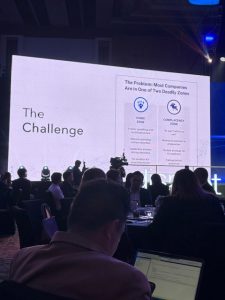The Philippines is keeping pace with many countries in the learning-experimentation phase of AI adoption and is making strong progress through partnerships with the government, according to an industry expert.
Terence Mauri, founder of the global think tank Hack Future Lab, was guest speaker at Globe Business Summit held on June 25, 2025, at The Grand Marriott Ballroon in Newport. Globe Business, the enterprise arm of Globe, convened top business leaders, digital pioneers, and technology partners for this year’s edition of G Summit. Anchored on the theme “Disrupt”, the event urged Philippine industries to proactively lead change through courageous transformation.
At the press conference, Mauri, a globally recognized thought leader on disruption, leadership and transformation, explained that most countries—including the Philippines—are currently trapped in the learning-experimentation zone, which is in between the panic zone and complacency zone.
In his research, Mauri observed that many countries find themselves stuck between two unproductive extremes. “We need to move from the panic zone or the complacency zone to be learning zone, so more proactive, more sandbox experimentation in partnership with government, non profit,” he said. Being in the learning zone, means the country is actively experimenting, as well as upskilling and reskilling its workforce.
While warning the audience not to fall into complacency, Mauri expressed confidence that the Philippines is showing strong momentum in AI adoption, particularly through collaboration with the government and non-profit organizations.
Challenges

In the panic zone, he said, companies are frantically upskilling with no infrastructure, investing massively without direction. These companies are characterized by leadership anxiety driving decisions with no sandbox for experimentation.
Those in the complacency zone just won’t allow AI to affect them yet, minimal investment in preparation, no data strategy for AI readiness, and are falling behind unnoticed.
The Italian-born AI expert went on to describe how populations around the world can be segmented into three groups based on their relationship with AI. These are – AI Fluents, AI Familiars, and AI Avoiders.
The AI Fluents, he said, typically represent about a third of the population. This group uses AI intentionally and integrates it into their daily lives.
The second segment, AI Familiars, are “kind of on the fence”—aware of AI and familiar with its terminology, but not yet committed to using it. “Perhaps they’ve experimented a bit, but they don’t use it intentionally every day,” said the MIT mentor.
The third and final group, AI Avoiders, do not use AI at all. Interestingly, Mauri noted that in most companies, around 43 percent of employees use AI secretly. This could be due to fear of losing their jobs or being demoted.
But doing so, he said, “puts the person at a secret advantage because it helps that person to get ahead.”
Mauri, whose think tank is now based in London, said he continues to study AI fluency in countries around the world, including the Philippines.
He emphasized that companies best positioned to thrive are those willing to challenge their own models and urged leaders to embrace constant reinvention, built on experimentation and purpose.




